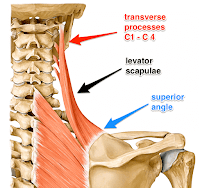| Latin | musculus levator scapulae |
|---|---|
| Origin | Posterior tubercles of transverse processes of C1 - C4 vertebrae |
| Insertion | Superior part of medial border of scapula |
| dorsal scapular artery | |
| cervical nerve (C3, C4) and dorsal scapular nerve (C5) | |
| Actions | Elevates scapula and tilts its glenoid cavity inferiorly by rotating scapula |
ANATOMY OF THE SPINE
submitted by Manna Lu
Bones of the Skull - Referenced by Colleen
 |
Anatomy of the Sternum:
The sternum, commonly known as the breastbone, is a long, narrow flat bone that serves as the keystone of the rib cage and stabilizes the thoracic skeleton. Several muscles that move the arms, head, and neck have their origins on the sternum. It also protects several vital organs of the chest, such as the heart, aorta, vena cava, and thymus gland that are located just deep to the sternum. It is located along the body's midline in the anterior thoracic region just deep to the skin. It is a flat bone about six inches in length, around an inch wide, and only a fraction of an inch thick. (http://www.innerbody.com)





omg this blog is giving me LIFE!!!
ReplyDelete